19.08.21
Interview – Ken Lindsay, Global Brand Ambassador, Chivas Bros.
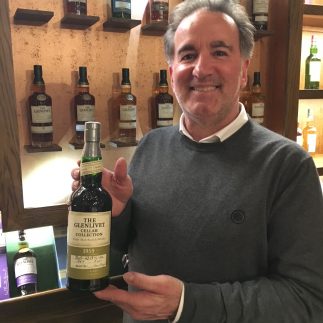 Actually, Ken Lindsay has just recently retired (early) from his global role within the Chivas Bros. arm of the Pernod Ricard empire, from where he has educated and charmed the trade and consumers round the world, largely about Ballantine‘s. A lot of people may not know he‘s also an accomplished rap artiste but I‘m not sure he used that in any of his whisky sessions! I first encountered Ken when we both worked for Allied Distillers in Dumbarton, me on malt whiskies and Ken on the Ballantine‘s aged portfolio. These interviews are intended to let us know more about the person behind the job and their path in and into whisky. So, where did life start for the young Ken?
Actually, Ken Lindsay has just recently retired (early) from his global role within the Chivas Bros. arm of the Pernod Ricard empire, from where he has educated and charmed the trade and consumers round the world, largely about Ballantine‘s. A lot of people may not know he‘s also an accomplished rap artiste but I‘m not sure he used that in any of his whisky sessions! I first encountered Ken when we both worked for Allied Distillers in Dumbarton, me on malt whiskies and Ken on the Ballantine‘s aged portfolio. These interviews are intended to let us know more about the person behind the job and their path in and into whisky. So, where did life start for the young Ken?
“I was born in Glasgow – in the east end. I have a twin sister, Gillian, but I was born 5 minutes earlier so she’s always called me her big brother. Also, she’s only 4′ 10½“. The family moved to Renfrew, a satellite town of Glasgow when the twins were small. “We were at school together and close but unalike physically. I was quite good at school and loved sports. particularly athletics and football. I was small and wiry and quite fast. In the Boys Brigade and Scouts they got me into middle distance running.” Moving on to high school, Ken felt he was good at languages especially. His sporting interests were maintained and included badminton, even after school days. Having given it up aged  about 30, he “leapt back on to the court at 50 and promptly ripped my achilles tendon”. Ken went on to run the first ever Glasgow Marathon, “sponsored by Scott’s Porridge Oats!” in his early twenties. I’ve seen the photograph but, sadly, it wasn’t made available for this article. A very keen junior golfer from age 11- 17, golf is a sport he has continued to enjoy playing and intends to do even more. I can say, by his own admission, he’s been on the course quite a bit since his recent retirement.
about 30, he “leapt back on to the court at 50 and promptly ripped my achilles tendon”. Ken went on to run the first ever Glasgow Marathon, “sponsored by Scott’s Porridge Oats!” in his early twenties. I’ve seen the photograph but, sadly, it wasn’t made available for this article. A very keen junior golfer from age 11- 17, golf is a sport he has continued to enjoy playing and intends to do even more. I can say, by his own admission, he’s been on the course quite a bit since his recent retirement.
I knew some of Ken‘s employment history but wondered what was his route all the way to the whisky industry. Having left school with exam passes in English, French and chemistry he wasn‘t keen on university, despite encouragement so chose a general management apprenticeship with Coates Paton, world renowned manufacturer of sewing threads and textiles, owner of Jaeger and Coates Viyella amongst other brands. That was the late 1970‘s when there were plenty of jobs to apply for and often a number of offers to choose from. This Coates apprenticeship meant moving round the UK working in different parts of the company , also being sponsored by it to follow a business course at college, though Ken had no career plan as to what he would do with it. It showed him what he didn‘t want to do (accountancy and finance). However, it did allow some time working in marketing, advertising and promotions which he found quite exciting and interesting. Other jobs followed – including one in advertising and promotions where he was sacked for his honesty! A stint in the hospitality, leisure and pub trade with Stakis Hotels followed until he alighted at Whyte & Mackay as an export marketing executive in 1988, subsequently deciding whisky was where he belonged. It does rather get into the system and doesn‘t let go.
Then why the move to Allied Distillers and the Ballantine‘s Aged Blends, I wondered? A bigger job is the simple answer. 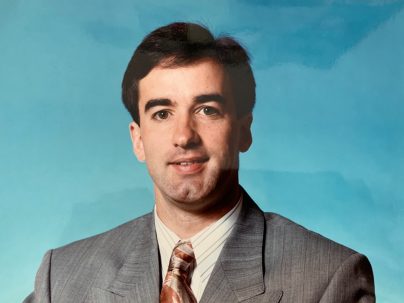 W&M were not so big in exports then as their single malts were not promoted as they are now and the W&M blend was largely a UK brand though Ken did get to travel and experience other cultures, his first trip being to Singapore in 1988. A bigger salary was another part of the decision and a bigger league brand so he arrived at Allied Distillers in 1990 (look at the fresh-faced youth) to a job that was more hands-on in all areas of marketing from strategy development to the detail of packaging and launching new expressions. It was big on strategy, international marketing and focusing on specific markets with specific brands. The aged, or prestige, blends were all about packaging, prestige and positioning and a high end strategy was developed focusing mainly on Far Eastern markets at that point.
W&M were not so big in exports then as their single malts were not promoted as they are now and the W&M blend was largely a UK brand though Ken did get to travel and experience other cultures, his first trip being to Singapore in 1988. A bigger salary was another part of the decision and a bigger league brand so he arrived at Allied Distillers in 1990 (look at the fresh-faced youth) to a job that was more hands-on in all areas of marketing from strategy development to the detail of packaging and launching new expressions. It was big on strategy, international marketing and focusing on specific markets with specific brands. The aged, or prestige, blends were all about packaging, prestige and positioning and a high end strategy was developed focusing mainly on Far Eastern markets at that point.
It was a successful time, with Ken‘s first project being the launch of Ballantine‘s Gold Seal 12 Year Old, differentiated from 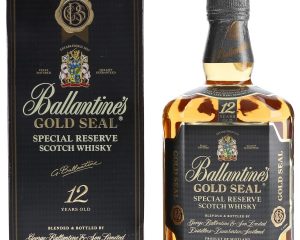 the regular Ballantine‘s. He took the chance to learn from renowned blender, Jack Goudie. Plugging a price/quality gap in a range that had 12, 17 and 30 year old followed with the fabulous Ballantine‘s 21 Year Old
the regular Ballantine‘s. He took the chance to learn from renowned blender, Jack Goudie. Plugging a price/quality gap in a range that had 12, 17 and 30 year old followed with the fabulous Ballantine‘s 21 Year Old 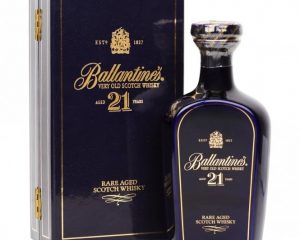 (which has now been through several pack incarnations since then), created by Jack. Ken notes with amusement that it was created to compete with Royal Salute – which is now also in the Chivas portfolio he took on later when Pernod Ricard bought Allied Distillers – but not a „me too“ pack. He also identified the opportunity for a duty free exclusive which was Ballantine‘s 19 (including a feather quill which he says, tongue in cheek, „was a joy to source and check through with Health and Safety“. His favourite launch was for Purity, a 20 year old blended malt, when no one else was doing one at the time, „So we were at the forefront of that category“. Another launch was Ballantine‘s 18 purely for Venezuela so it would not be paralleled into Japan, like other expressions in the range.
(which has now been through several pack incarnations since then), created by Jack. Ken notes with amusement that it was created to compete with Royal Salute – which is now also in the Chivas portfolio he took on later when Pernod Ricard bought Allied Distillers – but not a „me too“ pack. He also identified the opportunity for a duty free exclusive which was Ballantine‘s 19 (including a feather quill which he says, tongue in cheek, „was a joy to source and check through with Health and Safety“. His favourite launch was for Purity, a 20 year old blended malt, when no one else was doing one at the time, „So we were at the forefront of that category“. Another launch was Ballantine‘s 18 purely for Venezuela so it would not be paralleled into Japan, like other expressions in the range.
I wondered about the language skills at this point as Ken now speaks several. He pursued a French diploma course while at 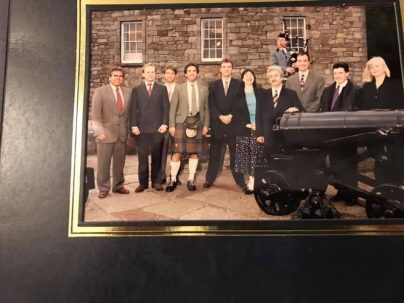 W&M via Glasgow‘s Alliance Française. A later boss landed him in it when he introduced Ken to the French CEO of Pernod Ricard, saying, „Ken speaks good French“, then walked off and left him to prove it. Fortunately, the CEO agreed. Portuguese as a result of the work he was to do in Brazil? „Yes, but also due to holidays in Portugal‘s Algarve.“ There speaks a golfer. Ken had also taken the opportunity to learn Spanish through an immersion course in Madrid, as Spain was Ballantine‘s largest market and there was work to be done in Latin America and Miami. He was obviously right about being good at languages from his school days. Italian was learned mainly as a hobby – though Italy was also an important Ballantine‘s market – as a colleague of ours went on to teach evening classes and lassoed him into the class saying there weren‘t enough men participating. He‘s also had plenty of work to do more recently with the Chinese market but he declares Mandarin „too tricky“. Despite an admission of an ear for languages, Ken does admit to an occasional mistake. Thinking of French rather than Spanish in a Venezuelan bar he meant to tell a large gathering of bartenders that the Ballantine‘s brand went „head to head“ with a competitor but what came out was „tit to tit“. I‘m sure many of us have made similar mistake… Ken comments that even if you do make mistakes people will credit you for trying and likes to learn some phrases in the more difficult languages too to make an effort for his hosts.
W&M via Glasgow‘s Alliance Française. A later boss landed him in it when he introduced Ken to the French CEO of Pernod Ricard, saying, „Ken speaks good French“, then walked off and left him to prove it. Fortunately, the CEO agreed. Portuguese as a result of the work he was to do in Brazil? „Yes, but also due to holidays in Portugal‘s Algarve.“ There speaks a golfer. Ken had also taken the opportunity to learn Spanish through an immersion course in Madrid, as Spain was Ballantine‘s largest market and there was work to be done in Latin America and Miami. He was obviously right about being good at languages from his school days. Italian was learned mainly as a hobby – though Italy was also an important Ballantine‘s market – as a colleague of ours went on to teach evening classes and lassoed him into the class saying there weren‘t enough men participating. He‘s also had plenty of work to do more recently with the Chinese market but he declares Mandarin „too tricky“. Despite an admission of an ear for languages, Ken does admit to an occasional mistake. Thinking of French rather than Spanish in a Venezuelan bar he meant to tell a large gathering of bartenders that the Ballantine‘s brand went „head to head“ with a competitor but what came out was „tit to tit“. I‘m sure many of us have made similar mistake… Ken comments that even if you do make mistakes people will credit you for trying and likes to learn some phrases in the more difficult languages too to make an effort for his hosts.
In the mid-90‘s when the company structure changed and whisky HQ/marketing moved to England, Ken wasn‘t happy. „I 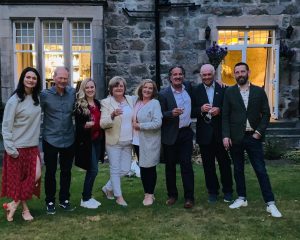 thought I would lose my job.“ All marketeers had to reapply for their jobs if they wanted to move. Ken had a young family and didn‘t want to move south. However, he applied and went through a 3-day assessment but didn‘t get the job he had done – very successfully – for the last five years. Corporate lunacy strikes again. A senior colleague in Scotland intervened, asking him to consider a brand ambassador role in a new team. Again, he wasn‘t keen but did the interview and got the job. „I told him I‘d give it 18 months. And here we are 25 years later.“
thought I would lose my job.“ All marketeers had to reapply for their jobs if they wanted to move. Ken had a young family and didn‘t want to move south. However, he applied and went through a 3-day assessment but didn‘t get the job he had done – very successfully – for the last five years. Corporate lunacy strikes again. A senior colleague in Scotland intervened, asking him to consider a brand ambassador role in a new team. Again, he wasn‘t keen but did the interview and got the job. „I told him I‘d give it 18 months. And here we are 25 years later.“
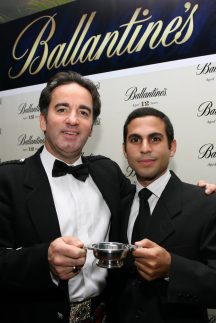 It was a puzzle to me why he hadn‘t tried for a marketing post with another whisky company. However, he and his new boss were wary of the old style brand ambassador, often the couthy, caricature, kilted emissary. To be fair, the kilt has been necessary on many occasions but not in the guise of the clichéd Scotsman. Ken was encouraged to be a different kind of brand ambassador, to develop the role in his own style. He was given complete freedom and says, „There was no manual. Given carte blanche to develop it gave me a sense of freedom – there was no template. Getting out there and learning from the markets and learning languages and getting out in front of people, eventually, after about 15 years of working life, I discovered my niche. I discovered what I was good at and enjoyed.“ Indeed, he did, with an enthusiastic following round the world. Ken was in at the beginning of the brand ambassador role as we tend to see it now and may have created that template that didn‘t exist before.
It was a puzzle to me why he hadn‘t tried for a marketing post with another whisky company. However, he and his new boss were wary of the old style brand ambassador, often the couthy, caricature, kilted emissary. To be fair, the kilt has been necessary on many occasions but not in the guise of the clichéd Scotsman. Ken was encouraged to be a different kind of brand ambassador, to develop the role in his own style. He was given complete freedom and says, „There was no manual. Given carte blanche to develop it gave me a sense of freedom – there was no template. Getting out there and learning from the markets and learning languages and getting out in front of people, eventually, after about 15 years of working life, I discovered my niche. I discovered what I was good at and enjoyed.“ Indeed, he did, with an enthusiastic following round the world. Ken was in at the beginning of the brand ambassador role as we tend to see it now and may have created that template that didn‘t exist before.
Once Pernod Ricard bought the company in 2005, Ken‘s responsibilities expanded as he took on Chivas Regal, Royal Salute, The Glenlivet. There was also a big job to do teaching all the new distribution and sales colleagues round the world all about Ballantine‘s, as well as the main PR board. Call it a coincidence but France were playing Scotland at Murrayfield that weekend and one of the directors told Ken Scotland had no chance. We beat them.
I asked if there were any really daft or difficult questions he‘d been asked. „Not daft, but certainly strange. I‘ve been asked some difficult technical questions by so-called connoisseurs and always said that I didn‘t know the answer as I wasn‘t a whisky maker and asked them, politely, if I did know the answer and told them, would it make any difference to their enjoyment of this great whisky? But you must do that without batting people down. You have to be the consumate diplomat. You‘re representing your brand, your industry and your country.“
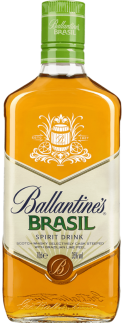 So what are the biggest changes Ken has seen in his 30+ years in Scotch Whisky? „The sheer rate and extent of innovation, certainly in the last 10 years. Not in line extensions but completely new products like the Ballantine‘s Brasil – with lime zest steeped in mature whisky casks, bottled as a spirit drink. It quickly gained about 400,000 cases through being offered to European markets too. It was the first time a global brand had gone into the flavour category. There‘s also Ballantine‘s Passion which is a tropical fruit-type flavour for mixing like rum with soda, coke, apple juice, anything you like. Then
So what are the biggest changes Ken has seen in his 30+ years in Scotch Whisky? „The sheer rate and extent of innovation, certainly in the last 10 years. Not in line extensions but completely new products like the Ballantine‘s Brasil – with lime zest steeped in mature whisky casks, bottled as a spirit drink. It quickly gained about 400,000 cases through being offered to European markets too. It was the first time a global brand had gone into the flavour category. There‘s also Ballantine‘s Passion which is a tropical fruit-type flavour for mixing like rum with soda, coke, apple juice, anything you like. Then 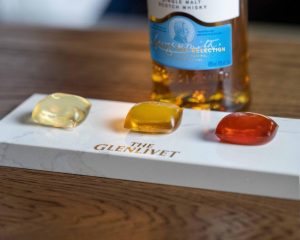 there are completely new things like The Glenlivet Cocktail Capsules. Those were quite a shocker to some people but they‘re not to replace The Glenlivet. They‘re to show a new way of drinking and enjoying it and bringing new people to the brand. On the consumer side, we give consumers much credit for being a lot more savvy now but also,wrongly, take for granted that all we speak to are really are knowledgeable about whisky.“
there are completely new things like The Glenlivet Cocktail Capsules. Those were quite a shocker to some people but they‘re not to replace The Glenlivet. They‘re to show a new way of drinking and enjoying it and bringing new people to the brand. On the consumer side, we give consumers much credit for being a lot more savvy now but also,wrongly, take for granted that all we speak to are really are knowledgeable about whisky.“
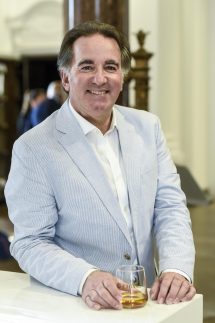 Given his varied roles within the industry what were Ken‘s favourite and least-liked aspects? „Exploring and discovering new cultures and countries is a favourite. Along with meeting many fascinating people. I‘ve been lucky enough to visit more than 85 countries. I like to get into the local areas and the great thing about working in the whisky industry is that you get into the restaurants and bars, hotels in the community; you get to learn a couple of languages and absorb the culture. We were pioneering in Russia in 1999. I was one of the first brand ambassadors to go to Russia. My first job as a BA was in Poland to launch the George Ballantine‘s shop in Warsaw.“
Given his varied roles within the industry what were Ken‘s favourite and least-liked aspects? „Exploring and discovering new cultures and countries is a favourite. Along with meeting many fascinating people. I‘ve been lucky enough to visit more than 85 countries. I like to get into the local areas and the great thing about working in the whisky industry is that you get into the restaurants and bars, hotels in the community; you get to learn a couple of languages and absorb the culture. We were pioneering in Russia in 1999. I was one of the first brand ambassadors to go to Russia. My first job as a BA was in Poland to launch the George Ballantine‘s shop in Warsaw.“
And least? „Airport delays and travel disruptions leading to wasted time. Long distance travel lost its fascination after 9/11. The thrill was getting to a place and working there. My biggest bugbear was the nuts and bolts of expenses – filling in the forms, the bureaucracy. There was also a frustration at the lack of understanding by some on what the role involves. I loved the job and wouldn‘t change it but people think you stay in 5-star hotels, visit nightclubs, drink lots of whisky, eat fabulous meals then jump in a taxi to an airport to come home. It needs a lot of preparation work.” [It does – been there.]” After a long flight you might start that day or early the next day with a launch to journalists, then a tasting session for the bar trade, media meetings, a training session with the local sales team, dinner with the local team if you‘re lucky then out to the night-time trade so a 14 – 16 hour day. There is certainly a glamorous element to it but all my mates who didn‘t really understand what I did thought I was like James Bond with the lifestyle of an international spy!” Well, there is a vacancy coming up there… “It‘s hilarious. To this day my Instagram handle is Bootleg 007.“
85 countries is a lot of world so what are Ken‘s favourite places to go for a) work and b) leisure?
As you might expect this was hard for him to choose but he reckons his spiritual home for work is South America, having been pretty much everywhere from Argentina to Venezuela and was the first BA to give brand training in Ecuador. He really has a soft spot for Asian countries too. For leisure he reckons the same type of places with the addition of some European venues like Portugal, parts of the Mediterranean coast and the Amalfi coast of Italy. „Actually, Italy in general.“ With his wife, they‘ve also enjoyed Caribbean destinations. He likes to be off the beaten track – Malaysia, Thailand, Borneo, „The road less travelled is a nice expression“ and isn‘t a package holiday fan. We narrowed it down finally to Latin America – all of it! – for work and the Med for holiday.
Now that he has time to kick back a bit, has Ken had any unfulfilled ambitions for work or leisure? „Not many unfulfilled work ambitions in terms of career development. I‘ve not been to Australia or New Zealand for work so I‘d like to go as a tourist for about a month. I‘d like to take my wife to parts of Mexico, Brazil and Chile that I‘ve been to. I‘d also like to do wine tours of Latin America and a pipedream of Europe with a week each in France, Italy and Spain concentrating only on wine regions.“ I can certainly help with recommendations for the latter.
In terms of current hobbies and interests, golf is a big one (seen here golfing in Poland) as well as watching rugby and football . As a huge fan of music, 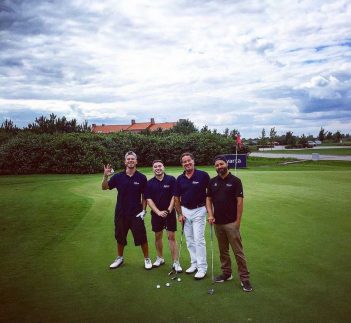 Ken would also like to get back to attending live gigs. When he turned 60 he treated himself to a new guitar but it hasn‘t
Ken would also like to get back to attending live gigs. When he turned 60 he treated himself to a new guitar but it hasn‘t 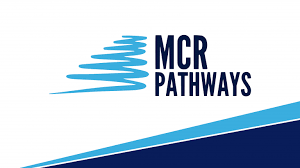 been used much – he practices just for his own enjoyment. Now, I knew that Ken also volunteers in certain places and wondered if that would continue. It will. He volunteers for MCR Pathways which he found out about from a journalist neighbour who put an ad in the paper for mentors to young people who maybe don‘t have too many advantages in life. It involves a little training and leads to mentoring a young person at high school for maybe an hour a week. He says, „You‘re not a teacher or a social worker or someone in authority or the police or involved in pastoral care. You lend an ear, you’re a listening post and can also talk to the young person about opportunities there might be for them.“ Those BA talking and listening skills come in handy for many things.
been used much – he practices just for his own enjoyment. Now, I knew that Ken also volunteers in certain places and wondered if that would continue. It will. He volunteers for MCR Pathways which he found out about from a journalist neighbour who put an ad in the paper for mentors to young people who maybe don‘t have too many advantages in life. It involves a little training and leads to mentoring a young person at high school for maybe an hour a week. He says, „You‘re not a teacher or a social worker or someone in authority or the police or involved in pastoral care. You lend an ear, you’re a listening post and can also talk to the young person about opportunities there might be for them.“ Those BA talking and listening skills come in handy for many things.
Also, he met by chance an old school friend who is a language teacher and who persuaded him to come in and talk to school pupils about the advantages of learning languages and and careers using them. As a language graduate myself, I can totally agree it‘s a good thing. Word got round so he was asked to do more and a little further afield than his immediate home area. He finds it „really rewarding and enjoyable“ to speak to school pupils and give them the extra bit of encouragement to pursue language studies.
I can‘t imagine Ken Lindsay sitting around on his backside doing very little in retirement, so any future plans? „Nothing specific in paid for or official work. I‘ve enjoyed 45 years of work life and it‘s now time to devote to other things. I‘ll continue with the mentoring. I also volunteer at a centre near Glasgow for rescue dogs from Romania. It‘s a farm converted for dog rehabilitation, dogs which have suffered ill-treatment and neglect and which can go on to new homes here. I do odd jobs there.“ I wondered why dogs from Romania but it seems they have a lot of strays and abandoned dogs there. I have seen some of it myself in one part of the country but didn‘t realise the extent of the problem.
Finally came the big question – if Ken were to be stuck on a desert island what‘s the one whisky he would want with him?  My warnings of just one caused some anguish and whether he could have a blend and a malt. No! Scapa 16 is a favourite malt and Chivas Ultis (created by several of the Chivas Master Blenders) as a blended malt but top of the list came Ballantine‘s 17 year old. The style he leans towards is complex with bourbon cask influence, sweetness, honey, vanilla and touch of smoke. This was one Ken learned about from Jack Goudie who told him he might taste a lot of whiskies but never a better one than this. It’s remained true for him throughout
My warnings of just one caused some anguish and whether he could have a blend and a malt. No! Scapa 16 is a favourite malt and Chivas Ultis (created by several of the Chivas Master Blenders) as a blended malt but top of the list came Ballantine‘s 17 year old. The style he leans towards is complex with bourbon cask influence, sweetness, honey, vanilla and touch of smoke. This was one Ken learned about from Jack Goudie who told him he might taste a lot of whiskies but never a better one than this. It’s remained true for him throughout
A throwaway comment as we ended our chat was mention of the time he was arrested in Japan for wearing his sgian dubh (the dagger that‘s part of a Scotsman‘s national dress) in his sock, as is the custom. A teaser line with no more details. Maybe that James Bond thing has more truth in it! As I said at the start, Ken has now ceased striding the globe on behalf of the Chivas Bros. brands and the farewells were not as extensive as they might have been thanks to the Covid pandemic. I did joke that he could have had a series of farewell events right round the world as many would have been delighted to host him. They probably still would later on, such has been Ken‘s exceptional contribution to enthusing and educating trade, media and consumers. I reckon if he manages those trips to South America he‘ll be amongst friends wherever he goes.
 Back again at the end of this month. Until then, why not try Ballantine‘s and Chivas drams, if you haven’t drunk them for a while, to remind yourself of just how good they are.
Back again at the end of this month. Until then, why not try Ballantine‘s and Chivas drams, if you haven’t drunk them for a while, to remind yourself of just how good they are.
Slainte,
Caroline
Comments